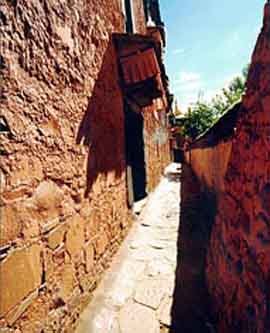| Legole.Com Discover china. Explore the beauty and wonder of the land, people, and culture of China. |
 |
|
|
 |
 This monastery is a "must see" for visitors to Tibet. The monastery lies 130 kilometers (80 miles) southwest of Shigatse. Sakya, meaning "Grey Soil" in Tibetan since the soil surrounding it is gray; it is the central monastery of Sakyapa sect of Tibetan Buddhism. Its walls were painted in red, white and grey strips, which represent Manjushri, Avalokiteshvara and Vajrapani respectively. Since the monastery has a colossal collection of highly valuable art pieces, it is deemed as the "Second Dunhuang". The Drum River divides it into the Northern Monastery and the Southern Monastery. This monastery is a "must see" for visitors to Tibet. The monastery lies 130 kilometers (80 miles) southwest of Shigatse. Sakya, meaning "Grey Soil" in Tibetan since the soil surrounding it is gray; it is the central monastery of Sakyapa sect of Tibetan Buddhism. Its walls were painted in red, white and grey strips, which represent Manjushri, Avalokiteshvara and Vajrapani respectively. Since the monastery has a colossal collection of highly valuable art pieces, it is deemed as the "Second Dunhuang". The Drum River divides it into the Northern Monastery and the Southern Monastery.
Established first, the Northern monastery was founded by Khon Konchog Gyalpo in 1073, from which Sakyapa rose and once ruled Tibet. Unfortunately, it is nothing but ruins now due to its severe destruction during the Cultural Revolution (1966-1976). However the ruins still reflect its glory and splendor.
The fifth Sakya Throne Holder, Drogon Chogyal Phakpa, known as Phakpa, built the Southern Monastery in 1268. Phakpa was the spiritual guide of Kublai khan, a Mongolian Chinese emperor who granted Phakpa secular and religious authority over Tibet. After Phakpa, Sakyapa ruled over 100 years in Tibet. The Southern Monastery remains in better condition. A typical Mongolian structure, the fortress-like monastery covers a space of 45,000 square meters and is surrounded by a moat, and has an outer wall and inner wall. With fortifications and battlements atop, it has only one entrance on the east.
Lakhang Chenmo, the Main Chanting Hall, is the central structure of Sakya's inner courtyard. The hall, measuring 5,700 square meters, has 40 huge pillars, four of which are 1.2 meters (4 feet) in diameter. Legend tells us that the four pillars were carried and presented by a Chinese Emperor, a tiger, the Nereus and a wild yak. Wall murals in the hall depict the stories about the pillars. Besides statues of Buddhas, the hall houses the greatest religious library in Tibet, containing tens of thousands of sutras written in Tibetan, Chinese, Mongolian, and Sanskrit. Among them two sutras named Kanjur and Tanjur were written in ink produced from ground gold powder. In the chapel west of the hall mandala-making techniques are taught. Ngudung Lakhang, or the North Chapel, houses 11 silver-wrapped stupas of former Sakyapa Throne Holders. Pukang, the Manjushri Chapel, contains a Jowo Sakyamuni, a Manjushri and other statues.
Sakya has countless murals, mostly of the Yuan dynasty (1271-1368). Among them, murals of mandalas and former Sakya Throne Holders are the most outstanding. The Sakyapa sect allows marriage and its religious power is descended from paternal uncle to nephew while its political authority from father to son. Sakya's collection of treasures also contains 3,000 pieces of pattra sutras written in Tibetan, Chinese, Mongolian and Sanskrit which cover a wide range of knowledge; other artifacts such as seals, crowns, robes, Buddhist vessels and statues bestowed by emperors of the Yuan Dynasty are also on display there.
Last year a seventy million Yuan (8.5 million US$) national fund had been allocated to renovate and rebuild Sakya Monastery. The reconstruction has begun although the Northern Monastery is still covered with rubble except for a newly built stupa, which contains relics of the first Sakya Throne Holder.
Admission Fee: RMB 45 |
 |
|
|
 |
|
